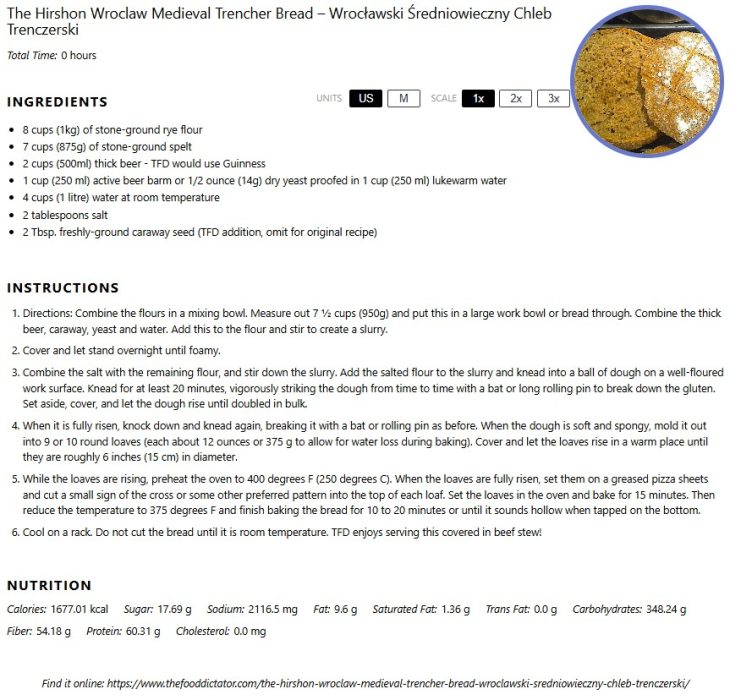
Word of the Day: Trencherman
Today’s word of the day, thanks to Words Coach (https://www.wordscoach.com/dictionary) is trencherman. Pronounced / ˈtrɛn tʃər mən / (just as one would expect), a trencherman is “a person who has a hearty appetite; a heavy eater” or “Archaic., a hanger-on; parasite” (https://www.dictionary.com/browse/trencherman). Dictionary.com adds under Word Origin “First recorded in 1580–90; trencher + -man” (ibid.). Samuel Johnson, in his 1755 Dictionary, defines it as “an eater; a feeder” and provides a quotation from Shakespeare’s Much Ado about Nothing: “Sidney.
You had musty victuals, and he hath help to eat it: he’s a very valiant trencherman; he hath an excellent stomach” (https://johnsonsdictionaryonline.com/views/search.php?term=trencherman). Merriam-Webster provides a similar definition, and Etymonline.com does not have an entry for trencherman at all.
So how does trencherman become a word that means a person who eats heartily? Dictionary.com gives us the clue, which is the word trencher, a word which to modern ears sounds like it would have to do with digging trenches. But a trencher, in addition to referring to a person who digs trenches, refers to “a rectangular or circular flat piece of wood on which meat, or other food, is served or carved” or “such a piece of wood and the food on it” and even “Archaic., food; the pleasures of good eating” (https://www.dictionary.com/browse/trencher).
Trencher enters the English language “c. 1300, trenchour, ‘wooden platter on which to cut meat,’ also ‘slice of stale bread used as a platter for food;’ from Anglo-French trenchour, Old North French trencheor ‘a trencher,’ literally ‘a cutting place,’ from Old French trenchier ‘to cut, carve, slice’ (see trench (n.)).
“Also the name for a type of knife or cutting tool (mid-14c.). Related: Trencher-bread (early 15c.) and many other compounds; a trencher-buffoon was ‘one who amuses persons at their dinner’” (https://www.etymonline.com/search?q=trencher).
In searching the web, I found a webpage by Jonathan Hirshon called The Food Dictator (https://www.thefooddictator.com/). Hirshon is a long-time Silicon Valley figure who does PR and is responsible for the Spartacus hack, a strategy for confusing facial recognition software. He’s been doing the Food Dictator page for over a decade, and his goal seems to be to introduce recipes from all over the world to his readers. Unfortunately, the Food Dictator site does not have an About page, perhaps out of Hirshon’s desire to maintain some anonymity. And I have to say that I do not like the name of the page nor the video that introduces one to the page (https://www.thefooddictator.com/wp-content/uploads/2019/02/TFD-Avatar-Cold-Open-FINAL.mp4?_=1).
What brought me to Hirshon’s The Food Dictator is that on November 4, 2019, he posted a blog about the “The Hirshon Wroclaw Medieval Trencher Bread”: “Today, not only will I teach you a recipe for a hearty and delicious bread recipe from Poland’s Middle Ages, you’ll save significantly on time washing up from your meal afterwards as this bread is more than just a side – it is the actual PLATE from which you’ll be partaking your meal!” (https://www.thefooddictator.com/the-hirshon-wroclaw-medieval-trencher-bread-wroclawski-sredniowieczny-chleb-trenczerski/).
He explains that the trencher was a round loaf of bread cut in half, that was used as a plate. In medieval times the cooks often put a meat stew of some kind on the trencher, and the bread would sop up the grease and liquid that one associates with a stew. At the end of the meal, the bread could be eaten though more often the bread was given to the poor or sometimes fed to their dogs.
“Later the trencher evolved into a small plate of metal or wood, typically circular and completely flat, without the lip or raised edge of a plate. Trenchers of this type are still used, typically for serving food that does not involve liquid; the cheeseboard is perhaps the most common type in the West. An individual salt dish or squat open salt cellar placed near a trencher was called a ‘trencher salt’.
“A ‘trencherman’ is a person devoted to eating and drinking, often to excess; one with a hearty appetite, a gourmand. A secondary use, generally archaic, is one who frequents another’s table, in essence a pilferer of another’s food.
“A ‘trencher-fed pack’ is a pack of foxhounds or harriers in which the hounds are kept individually by hunt members and only assembled as a pack to hunt. Usually, a pack of hounds are maintained together as a pack in kennels” (ibid.).
The Food Dictator, in addition to providing interesting historical information, provides a recipe, and that is our image for today. You should try it and let me know how it turns out, though be careful about sharing it with friends or you might find yourself with a trencherman coming to your place every evening.